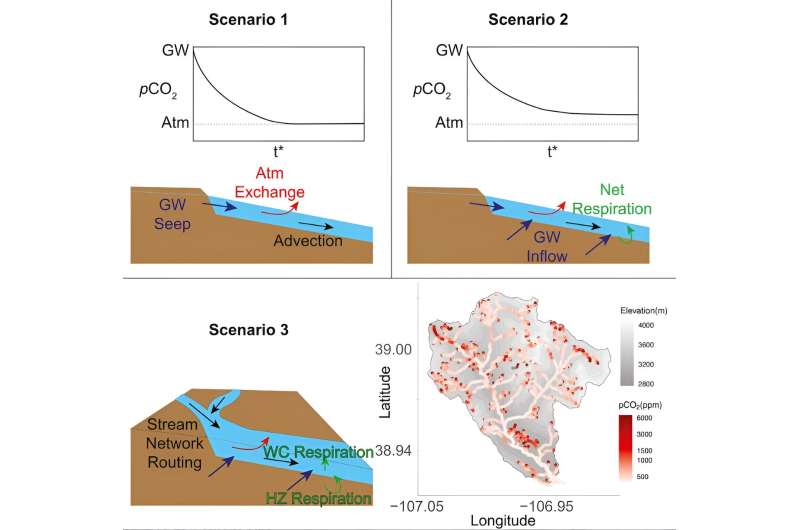This article has been reviewed according to Science X's editorial process and policies. Editors have highlighted the following attributes while ensuring the content's credibility:
fact-checked
trusted source
proofread
Scientists propose new method for tracking elusive origins of CO₂ emissions from streams

A team of researchers from the University of Massachusetts Amherst that specializes in accounting for the carbon dioxide release by streams, rivers and lakes has recently demonstrated that the chemical process known as "carbonate buffering" can account for the majority of emissions in highly alkaline waters. Furthermore, carbonate buffering distorts the most commonly used method of tracking the origins of CO2 in streams.
The research, published in Global Biogeochemical Cycles, proposes a better method for tracking the origin of riverine CO2 emissions.
Inland waters, including streams, rivers and lakes, account for roughly 5.5 gigatons of CO2 emissions annually—about 15% of what humans emit. But current climate models have trouble accounting for this carbon, says Matthew Winnick, assistant professor of Earth, Geographic and Climate Sciences at UMass Amherst and the paper's lead author, in part because much of this carbon seems to be produced cryptically, through carbonate buffering.
"The process is a little weird," says Winnick. "It acts as a kind of hidden reserve pool of CO2, replenishing carbon that is lost to the atmosphere, and ultimately increasing the amount of CO2 available for off-gassing."
To show how this hidden pool operates, Winnick and his co-author, then-UMass graduate student Brian Saccardi, looked to studies that focused on the carbon content of the oceans. "Carbonate buffering is a really well-known phenomenon in the ocean," says Winnick, "and even though oceans work differently from inland waters, we were able to borrow the geochemical equations to build a series of models that could account for a wide range of river and stream conditions."
So what is carbonate buffering? It begins with CO2—which is everywhere: in the air, in the soil and in water. When CO2 dissolves in water, it can react to form carbonic acid, which, through further reactions, can then become bicarbonate and carbonate. This reaction can also run in reverse, which means that high levels of bicarbonate and carbonate can act as reserve pools of CO2, driving emissions. This entire balance of CO2, water and carbonate is called "carbonate buffering," and the carbonate reserves can be emitted as a greenhouse gas from stream systems.
Indeed, Winnick and Saccardi found that this hidden pool can account for more than 60% of CO2 emissions under alkaline conditions.
There's yet another trick that carbonate buffering has up its sleeve. In the era of global warming, it is critically important to know both how much carbon is being emitted overall and where this carbon is coming from. "While we don't think stream emissions contribute to global warming, there is a big question about whether these emissions will change as climate warms, which could amplify warming in the future. To predict changes, we need to know where the CO2 is coming from," says Winnick.
But figuring out which molecule of CO2 came from which source is not a simple task. To track carbon, especially carbon emitted by bodies of water, scientists often use carbon isotopes, or versions of carbon with different masses, which act as a sort of forensic signature that can indicate the carbon's origin.
However, Winnick and Saccardi discovered that isotope signals in streams are highly sensitive to carbonate buffering reactions. "The primary way we use isotopes to track sources is through their relationship with CO2 concentrations, but carbonate buffering causes these relationships to break down," says Winnick. This breakdown can point to the wrong carbon culprit if not properly accounted for.
One way to account for carbonate buffering is to measure multiple isotopes of carbon, the new study suggests. Scientists typically only focus on one of the two tracer isotopes, because of the high cost of analyzing both, but the team has found that tracking the origins of both isotopes can help unmask the hidden sources of CO2.
More information: Matthew J. Winnick et al, Impacts of Carbonate Buffering on Atmospheric Equilibration of CO2, δ13CDIC, and Δ14CDIC in Rivers and Streams, Global Biogeochemical Cycles (2024). DOI: 10.1029/2023GB007860
Provided by University of Massachusetts Amherst



















